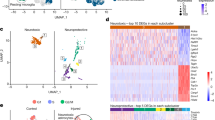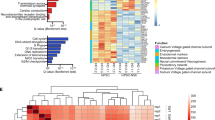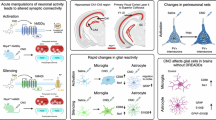Abstract
With recent progress in neuroscience and stem-cell research, neural transplantation has emerged as a promising therapy for treating CNS diseases. The success of transplantation has been limited, however, by the restricted ability of neural implants to survive and establish neuronal connections with the host. Little is known about the mechanisms responsible for this failure. Neural implantation triggers reactive gliosis, a process accompanied by upregulation of intermediate filaments in astrocytes and formation of astroglial scar tissue. Here we show that the retinas of adult mice deficient in glial fibrillary acidic protein and vimentin, and consequently lacking intermediate filaments in reactive astrocytes and Müller cells, provide a permissive environment for grafted neurons to migrate and extend neurites. The transplanted cells integrated robustly into the host retina with distinct neuronal identity and appropriate neuronal projections. Our results indicate an essential role for reactive astroglial cells in preventing neural graft integration after transplantation.
This is a preview of subscription content, access via your institution
Access options
Subscribe to this journal
Receive 12 print issues and online access
$259.00 per year
only $21.58 per issue
Buy this article
- Purchase on SpringerLink
- Instant access to full article PDF
Prices may be subject to local taxes which are calculated during checkout






Similar content being viewed by others
References
Studer, L., Tabar, V. & McKay, R.D. Transplantation of expanded mesencephalic precursors leads to recovery in parkinsonian rats. Nat. Neurosci. 1, 290–295 (1998).
Berson, E.L. & Jakobiec, F.A. Neural retinal cell transplantation: ideal versus reality. Ophthalmology 106, 445–446 (1999).
Dunnett, S.B. Repair of the damaged brain. Neuropathol. Appl. Neurobiol. 25, 351–362 (1999).
McDonald, J.W . et al. Transplanted embryonic stem cells survive, differentiate and promote recovery in injured rat spinal cord. Nat. Med. 5, 1410–1412 (1999).
Svendsen, C.N., Bhattacharyya, A. & Tai, Y.T. Neurons from stem cells: preventing an identity crisis. Nat. Rev. Neurosci. 2, 831–834 (2001).
Takahashi, M., Palmer, T.D., Takahashi, J. & Gage, F.H. Widespread integration and survival of adult-derived neural progenitor cells in the developing optic retina. Mol. Cell Neurosci. 12, 340–348 (1998).
Young, M.J., Ray, J., Whiteley, S.J., Klassen, H. & Gage, F.H. Neuronal differentiation and morphological integration of hippocampal progenitor cells transplanted to the retina of immature and mature dystrophic rats. Mol. Cell Neurosci. 16, 197–205 (2000).
Lu, B. et al. Transplantation of EGF-responsive neurospheres from GFP transgenic mice into the eyes of rd mice. Brain Res. 943, 292–300 (2002).
Gouras, P., Du, J., Kjeldbye, H., Yamamoto, S. & Zack, D.J. Long-term photoreceptor transplants in dystrophic and normal mouse retina. Invest. Ophthalmol. Vis. Sci. 35, 3145–3153 (1994).
Zhang, Y., Arner, K., Ehinger, B. & Perez, M.T. Limitation of anatomical integration between subretinal transplants and the host retina. Invest. Ophthalmol. Vis. Sci. 44, 324–331 (2003).
Seiler, M. & Turner, J.E. The activities of host and graft glial cells following retinal transplantation into the lesioned adult rat eye: developmental expression of glial markers. Brain Res. 471, 111–122 (1988).
Ghosh, F. & Wasselius, J. Muller cells in allogeneic adult rabbit retinal transplants. Glia 40, 78–84 (2002).
Fawcett, J.W. & Asher, R.A. The glial scar and central nervous system repair. Brain Res. Bull. 49, 377–391 (1999).
Eliasson, C. et al. Intermediate filament protein partnership in astrocytes. J. Biol. Chem. 274, 23996–24006 (1999).
Barker, R.A., Dunnett, S.B., Faissner, A. & Fawcett, J.W. The time course of loss of dopaminergic neurons and the gliotic reaction surrounding grafts of embryonic mesencephalon to the striatum. Exp. Neurol. 141, 79–93 (1996).
McGraw, J., Hiebert, G.W. & Steeves, J.D. Modulating astrogliosis after neurotrauma. J. Neurosci. Res. 63, 109–115 (2001).
Pekny, M. Astrocytic intermediate filaments: lessons from GFAP and vimentin knock-out mice. Prog. Brain Res. 132, 23–30 (2001).
Pekny, M. et al. Abnormal reaction to central nervous system injury in mice lacking glial fibrillary acidic protein and vimentin. J. Cell Biol. 145, 503–514 (1999).
Pekny, M. et al. Mice lacking glial fibrillary acidic protein display astrocytes devoid of intermediate filaments but develop and reproduce normally. EMBO J. 14, 1590–1598 (1995).
Gomi, H. et al. Mice devoid of the glial fibrillary acidic protein develop normally and are susceptible to scrapie prions. Neuron 14, 29–41 (1995).
McCall, M.A. et al. Targeted deletion in astrocyte intermediate filament (GFAP) alters neuronal physiology. Proc. Natl. Acad. Sci. USA 93, 6361–6366 (1996).
Colucci-Guyon, E. et al. Mice lacking vimentin develop and reproduce without an obvious phenotype. Cell 79, 679–694 (1994).
Menet, V. et al. Inactivation of the glial fibrillary acidic protein gene, but not that of vimentin, improves neuronal survival and neurite growth by modifying adhesion molecule expression. J. Neurosci. 21, 6147–6158 (2001).
Okabe, M., Ikawa, M., Kominami, K., Nakanishi, T. & Nishimune, Y. 'Green mice' as a source of ubiquitous green cells. FEBS Lett. 407, 313–319 (1997).
Smith-Thomas, L.C. et al. An inhibitor of neurite outgrowth produced by astrocytes. J. Cell. Sci. 107, 1687–1695 (1994).
McKeon, R.J., Schreiber, R.C., Rudge, J.S. & Silver, J. Reduction of neurite outgrowth in a model of glial scarring following CNS injury is correlated with the expression of inhibitory molecules on reactive astrocytes. J. Neurosci. 11, 3398–3411 (1991).
Cepko, C.L., Austin, C.P., Yang, X., Alexiades, M. & Ezzeddine, D. Cell fate determination in the vertebrate retina. Proc. Natl. Acad. Sci. USA 93, 589–595 (1996).
Young, R.W. Cell differentiation in the retina of the mouse. Anat. Rec. 212, 199–205 (1985).
Gan, L. et al. POU domain factor Brn-3b is required for the development of a large set of retinal ganglion cells. Proc. Natl. Acad. Sci. USA 93, 3920–3925 (1996).
Barnstable, C.J. & Drager, U.C. Thy-1 antigen: a ganglion cell specific marker in rodent retina. Neuroscience 11, 847–855 (1984).
Pekny, M. et al. GFAP-deficient astrocytes are capable of stellation in vitro when cocultured with neurons and exhibit a reduced amount of intermediate filaments and an increased cell saturation density. Exp. Cell Res. 239, 332–343 (1998).
Van Hoffelen, S.J., Young, M.J., Shatos, M.A. & Sakaguchi, D.S. Incorporation of murine brain progenitor cells into the developing mammalian retina. Invest. Ophthalmol. Vis. Sci. 44, 426–434 (2003).
Nishida, A. et al. Incorporation and differentiation of hippocampus-derived neural stem cells transplanted in injured adult rat retina. Invest. Ophthalmol. Vis. Sci. 41, 4268–4274 (2000).
Kurimoto, Y. et al. Transplantation of adult rat hippocampus-derived neural stem cells into retina injured by transient ischemia. Neurosci. Lett. 306, 57–60 (2001).
Qiu, J., Cai, D. & Filbin, M.T. Glial inhibition of nerve regeneration in the mature mammalian CNS. Glia 29, 166–174 (2000).
Fournier, A.E. & Strittmatter, S.M. Repulsive factors and axon regeneration in the CNS. Curr. Opin. Neurobiol. 11, 89–94 (2001).
Xu, K., Malouf, A.T., Messing, A. & Silver, J. Glial fibrillary acidic protein is necessary for mature astrocytes to react to beta-amyloid. Glia 25, 390–403 (1999).
Menet, V., Gimenez, Y.R.M., Sandillon, F. & Privat, A. GFAP null astrocytes are a favorable substrate for neuronal survival and neurite growth. Glia 31, 267–272 (2000).
Wang, X., Messing, A. & David, S. Axonal and nonneuronal cell responses to spinal cord injury in mice lacking glial fibrillary acidic protein. Exp. Neurol. 148, 568–576 (1997).
Acknowledgements
We thank B. Pawlyk and T. Li for conducting mouse retinal ERGs, D.W. Pottle for confocal microscopy and M. Young and C.L. Barnstable for critical discussion. This work was supported by grants from the National Eye Institute (EY012983), the Lilly Foundation for Aging Research, the Juvenile Diabetes Research Foundation, the Massachusetts Lion's Eye Research Fund and the Minda de GunzBurg Research Center for Retinal Transplantation at the Schepens Eye Research Institute (to D.F.C.) and by grants from the Swedish Cancer Foundation, the Swedish Medical Research Council, the Swedish Society for Medicine, the Swedish Society for Medical Research, the King Gustaf V Foundation, Volvo Assar Gabrielsson Fond and the Swedish Stroke Foundation (to M.P.).
Author information
Authors and Affiliations
Corresponding authors
Ethics declarations
Competing interests
The authors declare no competing financial interests.
Rights and permissions
About this article
Cite this article
Kinouchi, R., Takeda, M., Yang, L. et al. Robust neural integration from retinal transplants in mice deficient in GFAP and vimentin. Nat Neurosci 6, 863–868 (2003). https://doi.org/10.1038/nn1088
Received:
Accepted:
Published:
Issue date:
DOI: https://doi.org/10.1038/nn1088
This article is cited by
-
Intravitreal allogeneic mesenchymal stem cells: a non-randomized phase II clinical trial for acute non-arteritic optic neuropathy
Stem Cell Research & Therapy (2023)
-
Astrocyte Responses to Complement Peptide C3a are Highly Context-Dependent
Neurochemical Research (2023)
-
Retinal ganglion cell repopulation for vision restoration in optic neuropathy: a roadmap from the RReSTORe Consortium
Molecular Neurodegeneration (2023)
-
Bioengineering strategies for restoring vision
Nature Biomedical Engineering (2022)
-
The Long Non-coding RNA NEAT1/miR-224-5p/IL-33 Axis Modulates Macrophage M2a Polarization and A1 Astrocyte Activation
Molecular Neurobiology (2021)



